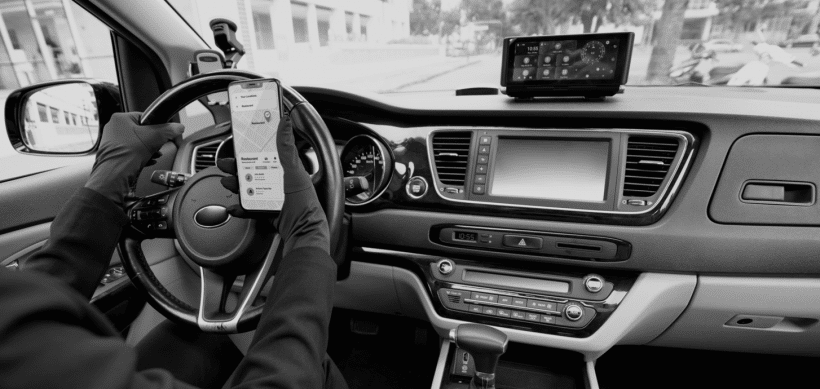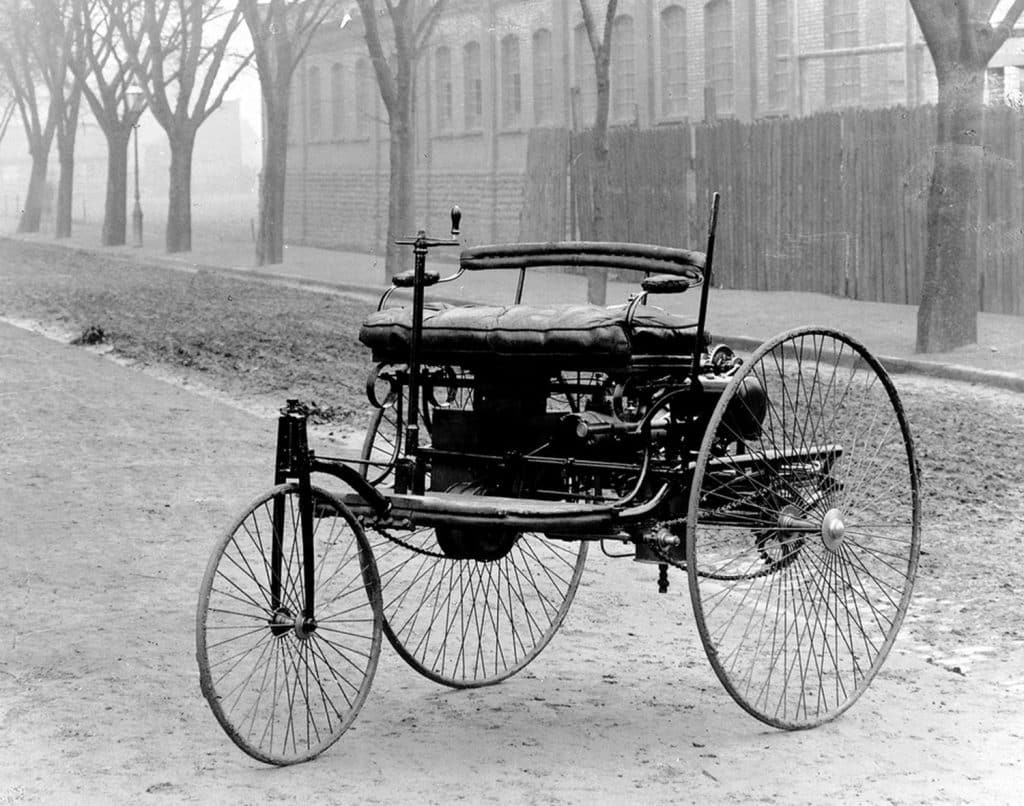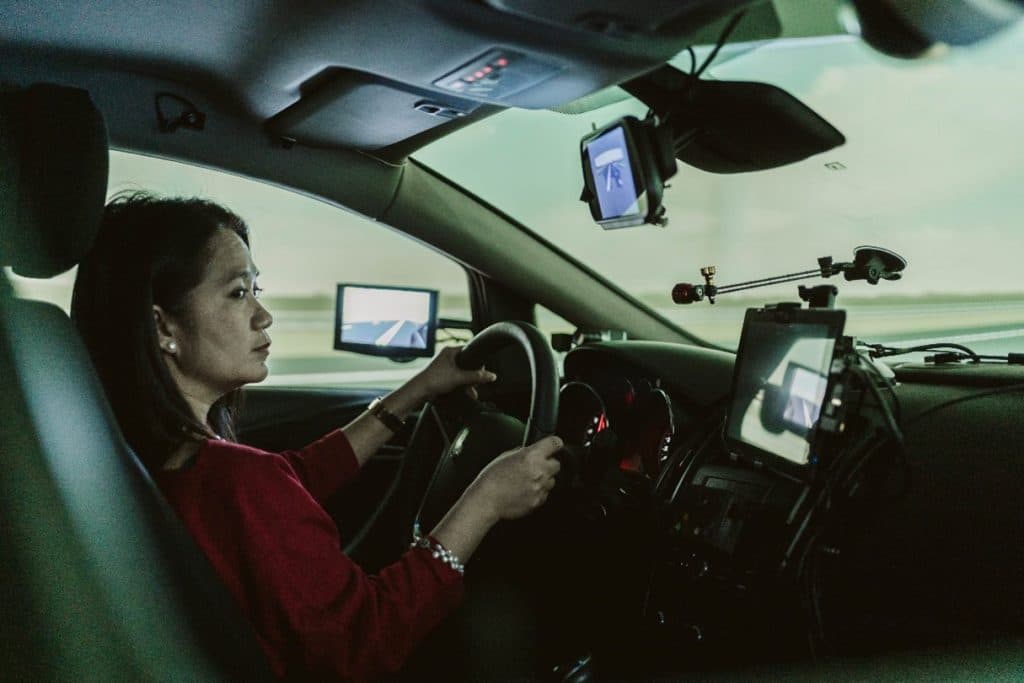Enter the search phrase

Authors:
Olga Zdzienicka, DMS Researcher @ Robotec.ai
Sylwia Mac, DMS Dataset Collection Coordinator @ Robotec.ai
Image by Freepik
***
When we think of user experience (UX), usually the first things that come to mind are smartphone apps, colorful buttons, and intuitive icons. Upon further consideration, we may recount the path trodden between sidewalks we walked this morning and wonder about the UX of urban spaces. Meanwhile, the truth is that UX is a part of many of our daily activities, and UX issues are present in almost every company, although not always under the formal name “User Experience”. As you’ve probably already guessed, they are also prevalent in automotive companies. What is our in-vehicle infotainment, if not a great human-machine interface (HMI)?
Once upon a time, before LCD screens went mainstream, the construction of in-vehicle infotainment (IVI) was much simpler, because it also had far fewer functions. The development of the human-machine interface was dictated by the development of widely available technology and devices that vehicle users had access to in their daily lives, like the aforementioned screens.

Source: Benz Patent-Motorwagen. In Wikipedia. https://en.wikipedia.org/wiki/Benz_Patent-Motorwagen. License: Public Domain.
The first vehicles had absolutely nothing in place of the dashboard – there was only a steering wheel and occasionally a horn, so it is difficult to talk about any infotainment. With the flow production of vehicles, functional elements such as a fuel gauge or speed monitor began to be added inside the vehicle. Over the decades, cars have slowly changed their role from solely a means of locomotion to a source of entertainment (Näätänen & Summala, 1985). Users expected vehicles to provide them with the devices and sources of enjoyment they were already accustomed to in their daily routines, and this entailed the need to install infotainment-type systems. As a result, manufacturers began to add more features, such as a radio, which was the first device on the dashboard serving not to provide information about the status of the vehicle, but to provide entertainment for the driver. This form has evolved and changed over the years – a cassette player was added to the regular radio, then it was replaced by a CD player, and now this function can be performed by a smartphone connected to the car computer via Bluetooth. Behind the radio, the classical Bell telephone tried to creep into the car, but automotive telephones did not gain popularity until their great comeback in the form, once again, of a cell phone wirelessly connected to the car. Of course, over time, cars were also equipped with Global Navigation Satellite Systems (GNSS), today inseparable and still present as part of car computers (Kern & Schmidt, 2009; Tepe, 2020).
The constant development of technology, together with the subsequent evolution of in-car infotainment parts led to an increasingly complex and intricate human-machine interface in car cabs. With the addition of each new feature to the dashboard, automotive companies found themselves introducing new pieces of equipment, buttons, and knobs. Recognizing the need for cohesion, they chose a unified GUI (graphic user interface) that seamlessly integrated new features, saved space, and improved driver navigation. when with the addition of each new feature to the dashboard, came a new piece of equipment, new buttons, and knobs, automotive companies decided they needed a single, consistent GUI (graphic user interface) to connect all the new features, save some space and make it easier for the driver to navigate all functionalities.
Slowly, the car computer has begun to resemble a smartphone – you can use it to check your email and weather, listen to music, reply to text messages, talk on the phone. Some models even have cameras for recording videos at stops or taking selfies. However, this development of the “entertainment” part of our vehicles had to be followed over time by regulations and laws that made sure that functionality and safety were not compromised in favor of the entertainment aspect of our infotainments. Let’s look at regulations that have responded to the development and expansion of car IVI.
Practical guidelines for automotive user interface design are essential for assigning a variety of instructions, as drivers interact with multiple displays, physical interfaces, and traffic information while driving. In addition, the air-conditioning and seat adjustment interface helps users reduce fatigue and enjoy entertainment in better driving conditions. The result is an overabundance of options and interfaces in modern cars that the driver can interact with during driving.
Local safety laws and regulations play an important role in designing the user interface in vehicles. These can apply to variables such as the scale of cluster clocks, the duration of seat belt alarms, the visibility of the windshield defroster switch, or any other vehicle systems, so basically every stage and element of the design. Still, specific and precise rules are not strictly set for most in-vehicle information and communication systems – the regulatory bodies present only nonbinding, voluntary guidelines (National Highway Traffic Safety Administration, 2013) or recommendations (European Commission, 2008). Their intention is to promote user-friendly and less distractive HMI design rather than to prohibit the inclusion of some functionalities or somehow hinder innovation within the industry. The European Union presents design goals, installation principles, and system behavior and interaction principles, all referring to ISO standards, and including good and bad examples that provide additional explanation concerning their implementation. This set of advice was issued in 2006, and may be somewhat outdated, considering the rapid technological developments witnessed over the last two decades. Since then, many research activities on the impact of various UX on driving safety were (and are still being) conducted. Through all these studies, we have gained profound insights that could influence future recommendations for good UX practices and potentially shape new regulations.
All of the abovementioned guideline recommendations can be summarized by the well-known part of the Hippocratic oath – primum non nocere, which means „first, do no harm”. In line with this motto, The European Commission’s (2008) design principles start with „The system supports the driver and does not give rise to potentially hazardous behavior by the driver or other road users.”. The principles offer detailed instructions, highlighting essential aspects such as “the allocation of driver attention, while interacting with system displays and controls, remains compatible with the attentional demand of the driving situation,” and emphasize that “the system does not distract or visually entertain the driver.”
The recent emergence of the draft Advanced Driver Distraction Warning regulation (European Commission, 2023) may suggest that there are still too many distractors within the vehicle cabin, and not all of the design goals have been met in new types of cars. Many other principles are quite intuitive, and (among others) state that: devices should not obstruct the driver’s view of the road scene or vehicle controls, displays should avoid glare and reflections, interacting with the system should allow the driver to keep at least one hand on the steering wheel, and should not require long and uninterruptible sequences of the manual-visual interface.
The Department of Transportation of the National Highway Traffic Safety Administration issued its notice (NHTSA, 2013) as part of the Driver Distraction Program to promote safety by discouraging the introduction of excessively distracting devices in vehicles. They opted to pursue nonbinding, voluntary guidelines rather than a mandatory Federal Motor Vehicle Safety Standard (FMVSS) because of the rapid pace of technological development in in-vehicle electronic devices and the need for additional research on distraction and its effects on driving. The NHTSA plans to update these guidelines in the future and expand its scope to include medium and heavy trucks and buses, but at the moment, their recommendations are similar to those presented by the European Commission (2008). They are based on fundamental principles including the following rules:
The guidelines recommend that devices in vehicles should be designed in a way that allows drivers to complete tasks quickly, without spending too much time looking away from the road. The NHTSA suggests a limit of single glances away from the roadway for a maximum of 2 seconds and a cumulative time spent looking away from the roadway for a maximum of 12 seconds (so that the task could be completed in a series of 1.5-second glances). Similar distraction thresholds can be found in the latest Euro NCAP testing procedures for safe driving (Euro NCAP, 2023) – a maximum of 3 seconds for an uninterrupted single long gaze away from the forward road, and a maximum of cumulative 10 seconds glancing within a 30 second period. It also means that vehicles fulfilling NHTSA recommendations can be assessed as being safer, and be rewarded with NCAP stars. In our previous blog posts, you can find additional information about driver distraction testing and related legislation: visual-based DMS approaches, and regulatory aspects of driver distraction testing.
As more and more, if not all, cars on the road are equipped with infotainment, the variety of such systems is also increasing. At this point, a few categories of systems can be found on the road, in the market, and in research (Angelini et al., 2016; Parada-Loira et al., 2014):
Each of these solutions has advantages; unfortunately, each also has considerable disadvantages. With haptic solutions, it’s important to remember that they use the same resources as the actual steering of the vehicle – visual attention and use of the hands. This means that when using more advanced haptic devices, such as touchscreens with nested menus, the driver must take his eyes off the road for even a few seconds and remove his hand from the wheel. With increasing device functionality, the sophistication of the devices is also increasing, as does the time it takes for the user to find their way around the GUI (Parada-Loira et al., 2014). However, if the haptic device is placed in an easily accessible, ergonomic location, and the user is able to remember the location associated with every function (here, it will probably be a bit easier with buttons and knobs than with a touchscreen) then it can be a very functional and comfortable solution. In response to this issue, some manufacturers have decided to relocate certain functions to fixed positions on the screen, like placing temperature controls at the bottom of the display. This way, the driver can always quickly locate them without having to take his eyes off the road for a long time. With the help of muscle memory, the driver can glance at the infotainment and take his hand off the steering wheel only for a moment, which is quite an advantage of this type of solution. Additionally, the reduction in equipment and visible hardware parts can result in a cleaner and more aesthetically pleasing interior of the car, which could be a plus for some drivers.
Another type of solution is voice-based. The driver doesn’t take his eyes off the road or his hands off the wheel, so this solution solves all the problems present in haptic systems. Additionally, it would seem that since drivers often talk to a passenger while driving, talking or giving voice commands should be done without affecting driving safety, right? Not really. To date, research shows that some in-vehicle voice interactions can have unintended consequences that negatively impact traffic safety. More advanced voice interactions are a significant cognitive distraction, even though the driver’s eyes and hands are not occupied with anything other than driving (Strayer et al., 2014; Parada-Loira et al., 2014). In addition, words are not always pronounced in the same way – articulation can be influenced by various factors, such as fatigue, which means that the system cannot always perfectly recognize speech, which in turn can lead to frustration or annoyance of the driver.
Gesture-based seems to be a bit of an intersection of the solutions already mentioned and are therefore both the best of both worlds and the worst of them. In the case of touch-based solutions, we have to keep in mind that the driver has to take his hand off the steering wheel. However, it should be remembered here that the driver is, as a rule, accustomed to taking one hand off the wheel, if only to change gear. Therefore, it can be considered that gesturing here is only a minor change and an addition (Parada-Loira et al., 2014; Ohn-Bar 2012). On the other hand, gestures, like words, do not always look the same, which can affect the smooth operation of the system and cause frustration in drivers.
As you can see, there are already a few existing solutions and they are diverse, both in terms of assumptions and in operation. Although each of these solutions uses different driver resources, there are studies that indicate that the overall performance of drivers using IVI of different types (haptic, voice-based and gesture-based) does not differ much (Angelini et al., 2016).
Of course, despite many disadvantages, the current infotainments, in general, have their pros – since everything is or can be tucked into one screen, cars can have very nice, clean, and clutter-free dashboards. In addition, functionality continues to increase – thanks to connectivity, cars can look for free parking spaces, provide real-time traffic updates to the driver or assist him in many other ways. This is the dawn of the smart car era, which, certainly for some, is a very exciting announcement.
If you have interesting insights on this topic or would like to discuss potential projects with us, contact us via humanfactors@robotec.ai!

Source: Robotec.ai
Angelini, L., Baumgartner, J., Carrino, F., Carrino, S., Caon, M., Khaled, O. A., … & Sonderegger, A. (2016). Comparing gesture, speech and touch interaction modalities for in-vehicle infotainment systems. In Actes de la 28e conférence francophone sur l’Interaction Homme-Machine on-IHM’16, 25-28 octobre 2016, Fribourg, Suisse. 25-28 October 2016.
Chung, S. (2022). Interface-Driven Customer Experience: Redefining User Interface (UI) Design for Automotive Infotainment System. IEEE Consumer Electronics Magazine, 12(1), 12-20.
Commission of the European Communities. (2023). COMMISSION DELEGATED REGULATION (EU) /… supplementing Regulation (EU) 2019/2144 of the European Parliament and of the Council by laying down detailed rules concerning the specific test procedures and technical requirements for the type-approval of certain motor vehicles with regard to their advanced driver distraction warning systems and amending that Regulation. Notified under document number C(2023)4523. URL: https://eur-lex.europa.eu/legal-content/EN/TXT/?uri=PI_COM%3AC%282023%294523&qid=1690444763962
Commission of the European Communities. (2008). Commission recommendation of 26 May 2008 on safe and efficient in-vehicle information and communication systems: Update of the European statement of principles on human-machine interface. Official Journal of the European Communities, L216, 1-42. Notified under document number C(2008) 1742 (2008/653/EC). URL: http://data.europa.eu/eli/reco/2008/653/oj
Davidovits, E. (2018). Reimagining in-car UX – eytan davidovits – medium. Medium. Https://medium.Com/@eytand/in-car-ux-7c5474d2b638
Driver Focus-Telematics Working Group. (2006). Statement of principles, criteria and verification procedures on driver interactions with advanced in-vehicle information and communication systems. Washington, DC: Alliance of Automobile Manufactures.
European New Car Assessment Programme. (2023). Assessment Protocol – Safety Assist Safe Driving, Version 10.2., June 2023.
Kern, D., & Schmidt, A. (2009, September). Design space for driver-based automotive user interfaces. In Proceedings of the 1st International Conference on Automotive User Interfaces and Interactive Vehicular Applications (pp. 3-10).
Li, W., Huang, J., Xie, G., Karray, F., & Li, R. (2021). A survey on vision-based driver distraction analysis. Journal of Systems Architecture, 121, 102319.
Moslemi, N., Soryani, M., & Azmi, R. (2021). Computer vision‐based recognition of driver distraction: A review. Concurrency and Computation: Practice and Experience, 33(24), e6475.
National Highway Traffic Safety Administration. (2013, April). Visual-Manual NHTSA Driver Distraction Guidelines for In-Vehicle Electronic Devices. Federal Register / Vol. 78, No. 81. URL: https://www.federalregister.gov/documents/2013/04/26/2013-09883/visual-manual-nhtsa-driver-distraction-guidelines-for-in-vehicle-electronic-devices
Näätänen, R., Summala, H. (1985). Zachowanie użytkowników dróg a wypadki drogowe. Warszawa: Państwowe Wydawnictwo Naukowe
Ohn-Bar, E., Tran, C., & Trivedi, M. (2012, October). Hand gesture-based visual user interface for infotainment. In Proceedings of the 4th International Conference on Automotive User Interfaces and Interactive Vehicular Applications (pp. 111-115).
Parada-Loira, F., González-Agulla, E., & Alba-Castro, J. L. (2014, June). Hand gestures to control infotainment equipment in cars. In 2014 IEEE Intelligent Vehicles Symposium Proceedings (pp. 1-6). IEEE.
Strayer, D. L., Turrill, J., Coleman, J. R., Ortiz, E. V., & Cooper, J. M. (2014). Measuring cognitive distraction in the automobile ii: Assessing in-vehicle voice-based. Accident Analysis & Prevention, 372, 379.
Tashev, I., Seltzer, M., Ju, Y. C., Wang, Y. Y., & Acero, A. (2009, September). Commute UX: Voice enabled in-car infotainment system. In Mobile HCI’09: Workshop on Speech in Mobile and Pervasive Environments (SiMPE).
Tepe, R. (2020). What is the Role of HCI Within the Automotive Industry? (Doctoral dissertation, Department of Digital Arts, Newcastle College).
Yang, H., Kim, Y., Jueng, M., Kim, Y., Park, J., & Yang, S. (2022, September). How Hyundai UX Team Develops. In Adjunct Proceedings of the 14th International Conference on Automotive User Interfaces and Interactive Vehicular Applications (pp. 165-167).